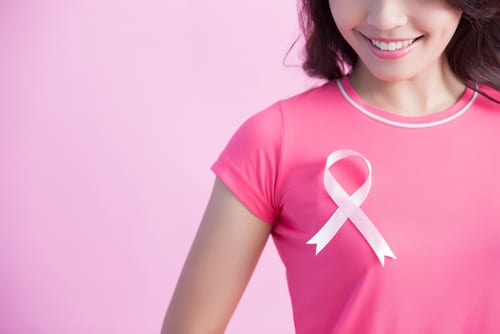
One in eight U.S women is diagnosed with breast cancer within their lifetime. With such a large percentage of women affected by breast cancer, knowing the signs and symptoms of this all too common disease is essential for women of all ages. Though the breast cancer mortality rate has been steadily declining since the 1980s, being able to detect and treat cancer immediately is crucial for successful removal and remission.
Signs of Breast Cancer
The signs of breast cancer are not as obvious as they might seem. While most people associate signs of breast cancer with the presence of lumps, breast cancer signs can come in several different forms. Lumps present in breast tissue can occasionally be cancerous and should immediately be reported to your doctor. However, most lumps tend to be benign and are not a sure and immediate sign of breast cancer.
Lumps can also appear near the collarbone and underarm and should be treated just as serious as breast lumps. The skin near the underarm or on the breasts may also harden and develop dimpling. In this case, the skin will develop the texture of a bumpy orange peel and can have the appearance of enlarged pores. Alert your doctor immediately if you experience any of these symptoms as they can be signs of inflammatory breast cancer, a rare but serious form of the disease.
Any presence of abnormal pain, skin redness or enlargement of pores near the breast can be another sign of breast cancer. While most breast pain is benign and not commonly associated with a positive diagnosis, it can be an early sign and should be reported to your doctor.
Other symptoms are changes in breast size or development of asymmetry that was not present previously. Breast cancer can change the size and shape of your breasts. Be sure to familiarize yourself with the size and shape of your breasts, especially during your regular monthly changes, so you can immediately detect an unusual or irregular change in their visual appearance. Swelling or shrinkage of the breasts, especially on one side of the body only, is a common symptom of breast cancer.
Finally, a change in nipple appearance or unexpected nipple discharge can be a warning sign of the disease. If your nipples begin to discharge clear or bloody liquid, especially from only one breast, then contact your doctor immediately. Non-bloody nipple leakage from both breasts is also a symptom of menopause, so be sure to consider other changes your body may be experiencing as a result of age or pregnancy. The nipples can also retract or change in shape and size during the onset of breast cancer.
Being in tune with your body is essential for spotting changes. You should be familiar with the shape and size of your breasts, especially during your monthly cycle. Being able to tell the difference between menopausal nipple leakage, leakage during or after pregnancy, and leakage that is a sign of breast cancer is important. However, if you have any doubts or concerns about changes in your body, be sure to contact your doctor right away for a check-up.
Prevention and Early Detection
Administering breast self-exams (BSE) used to be recommended to all women on a monthly basis. Recently, doctors have chosen to instead emphasize paying close attention to the visual details of your breasts to notice any minor changes immediately. If you do choose to perform routine BSE, then be sure to do them several days after your period ends to avoid confusion with regular hormonal changes. Go over the technique with your doctor if you are unsure how to properly administer a BSE. Mammograms are a great tool that can spot breast cancer up to two years before signs and symptoms of the disease are noticeable to patients. Mammograms are x-rays that specifically target breast tissue to spot changes related to breast cancer. The U.S. Department of Health and Human Services and the American College of Radiology recommend annual screening for every woman age 40 and older.
A breast biopsy is a sure way to tell if a lump is malignant or benign. After detecting a lump in your breasts through BSE or mammograms, your doctor can take a piece of tissue directly from the lump using a small needle. Sometimes, a small incision may have to be made to retrieve an adequate amount of tissue. The sample will then be analyzed to detect the presence of cancerous cells in the tissue. Your doctor will go over the results following your biopsy and discuss what your next step will be should the sample test positive.
Unfortunately, not much can be done to prevent breast cancer. Age and sex are the two biggest causes of the disease and are completely unavoidable. Genetics, including family members who have had the disease, can also lead to a slightly increased risk. If you have had breast cancer before and had it removed, be sure to continue protecting yourself to ensure you detect any further growth as soon as possible. The best way to prevent breast cancer is to take responsibility for your health and report any changes in your body to your doctor immediately.
Breast Cancer in Men
While breast cancer is a disease that affects almost exclusively women, men can be affected by the disease, too. Only one percent of all patients diagnosed with breast cancer are male. Unfortunately, the male mortality rate for breast cancer is much higher as men are less informed about the disease. Warning signs and treatment are largely the same with men as with women so talk to your doctor immediately if you are male and experience any of the common signs and symptoms of the disease.
Dr. David Lickstein and his staff at Lickstein Plastic Surgery understand how debilitating a breast cancer diagnosis can be. If you have had one or both breasts removed during a mastectomy, Dr. Lickstein is here to help. Dr. Lickstein is proud to be one of the first surgeons in Florida to perform single stage direct to implant reconstruction surgeries following nipple-sparing mastectomies. With this procedure, Dr. Lickstein can perform breast reconstruction following a mastectomy and restore your breasts to their original shape and size.
If breast cancer has taken a toll on your physical and mental health, Dr. Lickstein can help with his expert knowledge and extensive experience. Call Lickstein Plastic Surgery at 561-571-4000 to schedule an appointment and discuss your options today.






